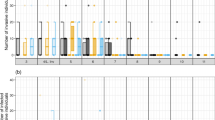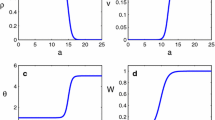Abstract
Parasites frequently reduce the fecundity, growth, and survival of individual hosts. How often do these virulent effects reduce the density of host populations? Spectacular examples show that recently invaded parasites can severely impact host populations—but what about parasites persisting long-term in host populations? We have addressed this issue using a zooplankton host (Daphnia dentifera) that becomes infected with a fungal microparasite (Metschnikowia bicuspidata). We combined observations of epidemics in nine lakes over 6 years, fine-scale sampling of three epidemics, and a mesocosm experiment. Most epidemics remained small (<10% maximum prevalence) and exerted little influence on host densities. However, larger epidemics more severely depressed the populations of their hosts. These large/severe epidemics started and peaked earlier than smaller/benign ones. The larger epidemics also exerted particularly negative effects on host densities at certain lags, reflecting the delayed consequences of infection on fecundity reduction and host mortality. Notably, negative effects on the juvenile stage class manifested later than those on the adult stage class. The results of the experiment further emphasized depression of host density by the fungus, especially on the density of the juvenile stage class. Consequently, this common parasite reduces the density of host populations when conditions foster larger outbreaks characterized by an earlier start and earlier peak. Given these considerable effects on host density seen in a number of large epidemics, parasitism may sometimes rank highly among other factors (predation, resource availability) driving the population dynamics of these hosts.




Similar content being viewed by others
References
Albon SD, Stien A, Irvine RJ, Langvatn R, Ropstad E, Halvorsen O (2002) The role of parasites in the dynamics of a reindeer population. Proc Roy Soc Lond B 269:1625–1632
Anderson RM, May RM (1979) Regulation and stability of host–parasite population interactions 1—regulatory processes. J Anim Ecol 47:219–247
Bittner K, Rothhaupt K-O, Ebert D (2002) Ecological interactions of the microparasite Caullerya mesnili and its host Daphnia galeata. Limnol Oceanogr 47:300–305
Cáceres CE, Hall SR, Duffy MA, Tessier AJ, Helmle C, MacIntyre S (2006) Physical structure of lakes constrains epidemics in Daphnia populations. Ecology 87:1438–1444
Cáceres CE, Knight CJ, Hall SR (2009) Predator spreaders: predation can enhance parasite success in a planktonic host–parasite system. Ecology 90:2850–2858
Caraco T, Glavanakov S, Chen G, Flaherty JE, Ohsumi TK, Szymanski BK (2002) Stage-structured infection transmission and a spatial epidemic: a model for Lyme disease. Am Nat 160:348–359
Decaestecker E, Declerck S, De Meester L, Ebert D (2005) Ecological implications of parasites in natural Daphnia populations. Oecologia 144:382–390
Dobson AP, Hudson PJ (1992) Regulation and stability of a free-living host–parasite system, Trichostrongylus tenuis in red grouse. II: population models. J Anim Ecol 61:487–498
Duffy MA (2007) Selective predation, parasitism, and trophic cascades in a bluegill–Daphnia–parasite system. Oecologia 153:453–460
Duffy MA, Hall SR (2008) Selective predation and rapid evolution can jointly dampen effects of virulent parasites on Daphnia populations. Am Nat 171:499–510
Duffy MA, Sivars-Becker L (2007) Rapid evolution and ecological host–parasite dynamics. Ecol Lett 10:44–53
Duffy MA, Hall SR, Tessier AJ, Huebner M (2005) Selective predators and their parasitized prey: are epidemics in zooplankton under top-down control? Limnol Oceanogr 50:412–420
Duffy MA, Brassil CE, Hall SR, Tessier AJ, Cáceres CE, Conner JK (2008) Parasite-mediated disruptive selection in a natural Daphnia population. BMC Evol Biol 8:80
Duffy MA, Hall SR, Cáceres CE, Ives AR (2009) Rapid evolution, seasonality, and the termination of epidemics. Ecology 90:1441–1448
Duffy MA, Cáceres CE, Hall SR, Tessier AJ, Ives AR (2010) Temporal, spatial and between-host comparisons of patterns of parasitism in lake zooplankton. Ecology 91:3322–3331
Ebert D (2005) Ecology, epidemiology, and evolution of parasitism in Daphnia. National Library of Medicine (USA), National Center for Biotechnology Information, Bethesda. Available at: http://www.ncbi.nlm.nih.gov/entrez/query.fcgi?db=Books
Ebert D, Lipsitch M, Mangin KL (2000) The effect of parasites on host population density and extinction: experimental epidemiology with Daphnia and six microparasites. Am Nat 156:459–477
Grundman AW, Warnock RG, Wassom DL (1976) Some mechanisms of natural regulation of parasite helminth populations. Am Mid Nat 95:347–360
Gulland FMD (1995) Impact of infectious diseases on wild animal populations: a review. In: Grenfell BT, Dobson AP (eds) Ecology of infectious diseases in natural populations. Cambridge University Press, Cambridge, pp 20–51
Hall SR, Duffy MA, Cáceres CE (2005) Selective predation and productivity jointly drive complex behavior in host–parasite systems. Am Nat 165:70–81
Hall SR, Tessier AJ, Duffy MA, Huebner M, Cáceres CE (2006) Warmer does not have to mean sicker: temperature and predators can jointly drive timing of epidemics. Ecology 87:1684–1695
Hall SR, Sivars-Becker L, Becker C, Duffy MA, Tessier AJ, Cáceres CE (2007) Eating yourself sick: transmission of disease as a function of feeding biology of hosts. Ecol Lett 10:207–218
Hall SR, Simonis JL, Nisbet RM, Tessier AJ, Cáceres CE (2009a) Resource ecology of virulence in a planktonic host–parasite system: an explanation using dynamic energy budgets. Am Nat 174:149–162
Hall SR, Knight CM, Becker CR, Duffy MA, Tessier AJ, Cáceres CE (2009b) Quality matters: food quality and the course of epidemics in a planktonic host–parasite system. Ecol Lett 12:118–128
Hall SR, Becker CR, Simonis JL, Duffy MA, Tessier AJ, Cáceres CE (2009c) Friendly competition: evidence for a dilution effect among competitors in a planktonic host–parasite system. Ecology 90:791–801
Hall SR, Smyth R, Becker CR, Duffy MA, Knight CJ, MacIntyre S, Tessier AJ, Cáceres CE (2010) Why are Daphnia in some lakes sicker? Disease ecology, habitat structure, and the plankton. Bioscience 60:363–375
Hochachka WM, Dhondt AA (2000) Density-dependent decline of host abundance resulting from a new infectious disease. Proc Natl Acad Sci USA 97:303–530
Holmes JC (1995) Population regulation—a dynamic complex of interactions. Wildl Res 22:11–19
Hudson PJ, Dobson AP, Newborn D (1998) Prevention of population cycles by parasite removal. Science 282:2256–2258
Hudson PJ, Dobson AP, Lafferty KD (2006) Is a healthy ecosystem one that is rich in parasites? Trends Ecol Evol 21:381–385
Ives AR, Dennis B, Cottingham KL, Carpenter SR (2003) Estimating community stability and ecological interactions from time-series data. Ecol Monogr 73:301–330
Johnson PTJ, Stanton DE, Preu ER, Forshay KJ, Carpenter SR (2006) Dining on disease: how interactions between infection and environment affect predation risk. Ecology 87:1973–1980
Johnson PTJ, Ives AR, Lathrop RC, Carpenter SR (2009) Long-term disease dynamics in lakes: causes and consequences of chytrid infections in Daphnia populations. Ecology 90:132–144
Keesing F, Holt RD, Ostfeld RS (2006) Effects of species diversity on disease risk. Ecol Lett 9:485–498
LaDeau SL, Kilpatrick AM, Marra PP (2007) West Nile virus emergence and large-scale declines of North American bird populations. Nature 447:710–714
Lafferty KD, Kuris AM (2009) Parasitic castration: the evolution and ecology of body snatchers. Trends Ecol Evol 25:564–572
Lafferty KD, Dobson AP, Kuris AD (2006) Parasites dominate food web links. Proc Natl Acad Sci USA 103:11211–11216
Lafferty KD, Dobson AP, Kuris AM (2008) Parasites in food webs: the ultimate missing links. Ecol Lett 11:533–546
Lampert W, Sommer U (2007) Limnoecology: the ecology of lakes and streams. Oxford University Press, Oxford
Leibold MA (1991) Trophic interactions and habitat segregation between competing species of Daphnia. Oecologia 86:510–520
Littell RC, Stroup WW, Freund RJ (2002) SAS for linear models. 4th edn. Wiley, New York
May RM, Anderson RM (1978) Regulation and stability of host–parasite population interactions—2 destabilizing processes. J Anim Ecol 47:249–267
McCauley E, Nelson W, Nisbet R (2008) Small-amplitude cycles emerge from stage-structured interactions in Daphnia–algal systems. Nature 455:1240–1243
Mills EL, Forney JL, Wagner KJ (1987) Fish predation and its cascading effect on the Oneida Lake food chain. In: Kerfoot WC, Sih A (eds) Predation: direct and indirect impacts on aquatic ecosystems. The University Press of New England, Hanover, pp 118–131
Minchella DJ, Scott ME (1991) Parasitism—a cryptic determinant of animal community structure. Trends Ecol Evol 6:250–254
Mutze G, Cooke B, Alexander P (1998) The initial impact of rabbit hemorrhagic disease on European rabbit populations in South Australia. J Wildl Dis 34:221–227
Price PW (1980) Evolutionary biology of parasites. Princeton University Press, Princeton
Redpath SM, Mougeot F, Leckie FM, Elston DA, Hudson PJ (2006) Testing the role of parasites in driving the cyclic population dynamics of a gamebird. Ecol Lett 9:410–418
Scott ME (1988) The impact of infection and disease on animal populations: implications for conservation biology. Conserv Biol 2:40–56
Scott ME, Dobson A (1989) The role of parasites in regulating host abundance. Parasitol Today 5:176–183
Scott ME, Lewis JW (1987) Population dynamics of helminth parasites in wild and laboratory rodents. Mamm Rev 17:95–103
Singleton GR, Chambers LK, Spratt DM (1995) An experimental field-study to examine whether Capillaria hepatica (Nematoda) can limit house mouse populations in Eastern Australia. Wildl Res. 22:31–53
Smyth RL (2010) Stratification and turbulent mixing in small strongly stratified lakes with implications for planktonic disease dynamics. PhD thesis. University of California, Santa Barbara
Tessier AJ, Woodruff P (2002) Cryptic trophic cascade along a gradient of lake size. Ecology 83:1263–1270
Tompkins DM, Begon M (1999) Parasites can regulate wildlife populations. Parasitol Today 15:311–313
Van Buskirk J, Ostfeld RS (1995) Controlling Lyme disease by modifying density and species composition of tick hosts. Ecol Appl 5:1133–1140
Welschmeyer NA (1994) Fluorometric analysis of chlorophyll a in the presence of chlorophyll b and pheopigments. Limnol Oceanogr 39:1985–1992
Acknowledgments
We thank R. Duffy, A. Morgan, D. Shumway, P. Woodruff, and A. Parsons-Field for help with field collection and sample processing and R. Penczykowski for reading a draft of the manuscript. The Albert, Champion, and Marshall families graciously permitted access to private lakes. NSF generously supported this research (OCE 02-35119, 02-35039; DEB 06-13510, 06-14316). This is contribution #1584 from the W.K. Kellogg Biological Station.
Author information
Authors and Affiliations
Corresponding author
Additional information
Communicated by David Marcogliese.
Electronic supplementary material
Below is the link to the electronic supplementary material.
Rights and permissions
About this article
Cite this article
Hall, S.R., Becker, C.R., Duffy, M.A. et al. Epidemic size determines population-level effects of fungal parasites on Daphnia hosts. Oecologia 166, 833–842 (2011). https://doi.org/10.1007/s00442-011-1905-4
Received:
Accepted:
Published:
Issue Date:
DOI: https://doi.org/10.1007/s00442-011-1905-4




